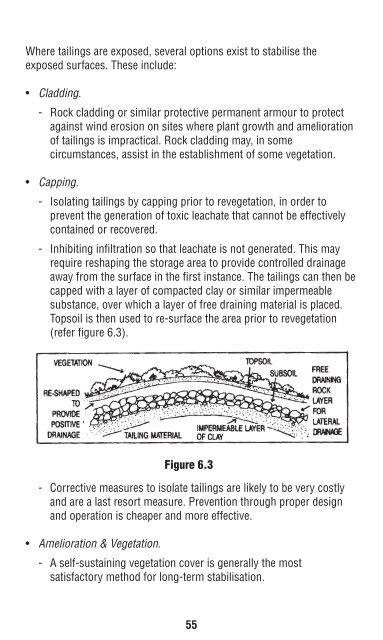Mine Rehabilitation Handbook - Mining and Blasting
Mine Rehabilitation Handbook - Mining and Blasting
Mine Rehabilitation Handbook - Mining and Blasting
You also want an ePaper? Increase the reach of your titles
YUMPU automatically turns print PDFs into web optimized ePapers that Google loves.
Where tailings are exposed, several options exist to stabilise the<br />
exposed surfaces. These include:<br />
• Cladding.<br />
- Rock cladding or similar protective permanent armour to protect<br />
against wind erosion on sites where plant growth <strong>and</strong> amelioration<br />
of tailings is impractical. Rock cladding may, in some<br />
circumstances, assist in the establishment of some vegetation.<br />
• Capping.<br />
- Isolating tailings by capping prior to revegetation, in order to<br />
prevent the generation of toxic leachate that cannot be effectively<br />
contained or recovered.<br />
- Inhibiting infiltration so that leachate is not generated. This may<br />
require reshaping the storage area to provide controlled drainage<br />
away from the surface in the first instance. The tailings can then be<br />
capped with a layer of compacted clay or similar impermeable<br />
substance, over which a layer of free draining material is placed.<br />
Topsoil is then used to re-surface the area prior to revegetation<br />
(refer figure 6.3).<br />
Figure 6.3<br />
- Corrective measures to isolate tailings are likely to be very costly<br />
<strong>and</strong> are a last resort measure. Prevention through proper design<br />
<strong>and</strong> operation is cheaper <strong>and</strong> more effective.<br />
• Amelioration & Vegetation.<br />
- A self-sustaining vegetation cover is generally the most<br />
satisfactory method for long-term stabilisation.<br />
55<br />
- Because of the inherent characteristics of most tailings, they will<br />
require some change to their physical <strong>and</strong>/or chemical properties<br />
in order to support satisfactory plant growth.<br />
- Methods used to assist plant growth include:<br />
a) Incorporation of Organic Materials <strong>and</strong> Mulches<br />
e.g. sewage sludge, organic mulches, fly-ash etc<br />
* Texture <strong>and</strong> structural characteristics are improved, aeration <strong>and</strong><br />
moisture infiltration <strong>and</strong> retention are increased.<br />
* Micro-organisms are introduced to the growth medium.<br />
* Organic materials tend to react with heavy metal ions <strong>and</strong> can<br />
reduce toxicity.<br />
* Woodchips, bark <strong>and</strong> similar materials when used fresh may<br />
absorb available nitrogen <strong>and</strong> release phenols adversely<br />
affecting plant growth. Where possible, stockpile prior to use.<br />
* Fly-ash <strong>and</strong> similar material have been effectively used to<br />
amend tailings material, but check levels of potential leachate<br />
contaminants prior to use.<br />
b) Correction of pH<br />
* Acidic conditions are common; the oxidation of pyrite is most<br />
frequently the source of acidity.<br />
* Plant growth is very limited at pH 4.5 or less. Correction of pH<br />
to 4.5 or above will substantially alter the availability of existing<br />
or introduced plant nutrients (refer appendix 5).<br />
* Various forms of lime are the most effective method of pH<br />
correction. Lime dem<strong>and</strong> may be excessive (in some cases 30<br />
tonnes calcium carbonate equivalent (cce)/hectare). Correction<br />
is generally impractical when required dosage rates exceed<br />
about 15 tonnes cce/hectare.<br />
* The acid-base status of the tailings material will determine the<br />
lime dem<strong>and</strong>, however, the following application rates can be<br />
used as a guide for treating weak or moderately acid tailings (or<br />
spoils etc):<br />
pH Application Rate (tonnes/hectare<br />
calcium carbonate equivalent)<br />
6.0 - 5.5 2 - 5<br />
5.4 - 4.6 6 - 9<br />
4.5 - 4.0 10 - 13<br />
56
















